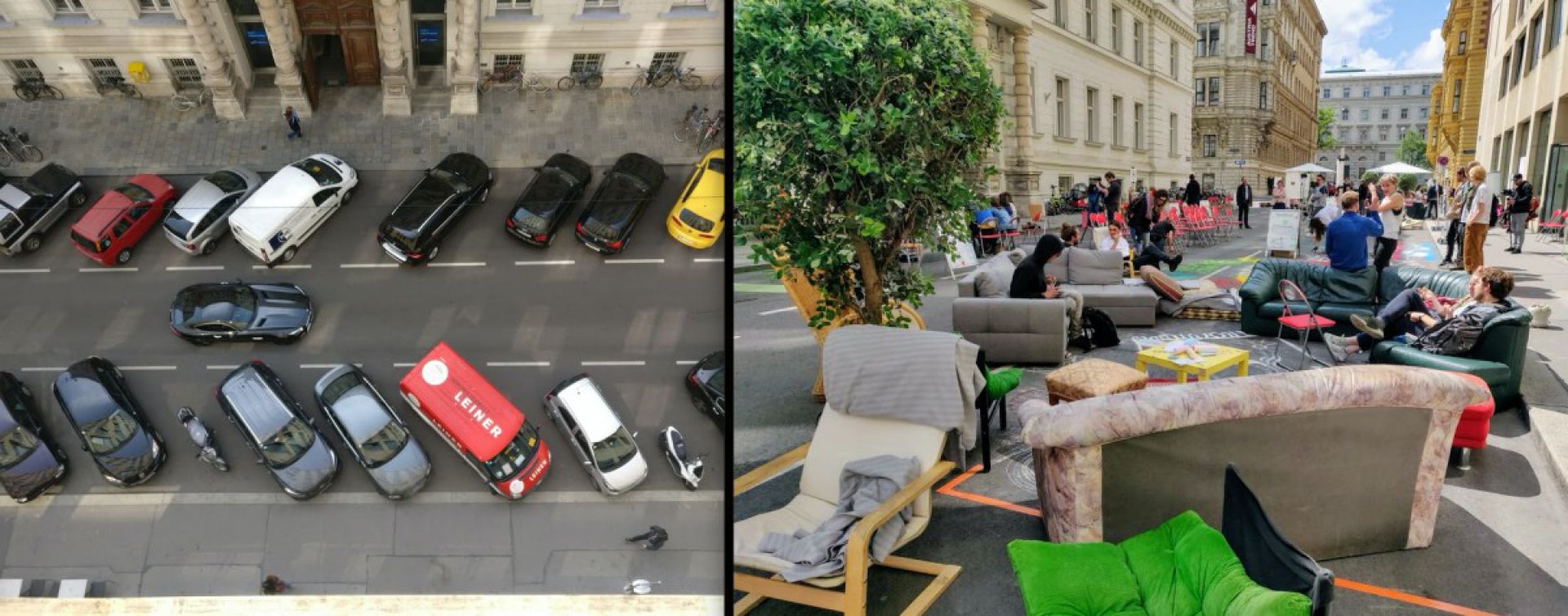Liebiggasse University Forum
Jahr: 2019
Bundesland: Wien

Ziele/Ideen
In the current situation, there is a lack of outdoor space for students to meet and interact – this applies to students and academic staff from two university buildings located at the Liebiggasse. Not only is there no outdoor space available for the buildings individually – the current spatial lay-out forms a barrier for interaction and exchange between the users of the two buildings. Furthermore, due to the prioritzation of car parking (mainly used by visitors of the university, not locals), there is limited space assigned for bikes to be parked.
As a result, the street’s design is far from welcoming nor incentivizing non-car use of the street.
Kurzbeschreibung
On Friday 17 May 2019, a group of University of Vienna students transformed a street next to their university building (Liebiggasse) into a public square. The objective of the temporary intervention called “Ich liebe Liebiggasse” was to show the street’s potential as an inclusive and multi-functional public space. A central part of this presented vision would be the transformation from a car-dominated street into a pedestrian-friendly, green university forum that invites its users to meet, exchange ideas and explore.Resultate
A free public forum called “Ich liebe Liebiggasse” was organized on the 17th of May 2019 which aimed to show alternative futures for a public space/university forum at the Liebiggasse to an audience of nearly 800 students, academics, city officials, locals and passers-by. The forum was organized as part of the three-day public space festival #KommRaus (https://www.kommraus.wien). The aim of the ‘Ich liebe Liebiggasse’ intervention was to show its potential as an inclusive and multi-functional public space: a pedestrian-friendly, green university forum that invites its users to meet, exchange ideas and explore.
Prior to the event, we informed ourselves about the feasability of our plan. This included several workshop sessions with professors representatives from the municipality and urban planners. During these sessions, we collected information about subterrainian infrastructure (utilities and pipes), traffic uses and local regulations. This – amongst others – allowed us to propose the possible locations of the green spaces as visualize the subterrainian constraints through an x-ray (painted on the street). In addition, residents were informed about the intervention through 1,000 mailers sent out prior to the event.
On the day, an agora was built to facilitate a space for public discussion, a workshop area was designated to host workshop which engaged people to enjoy the space, get creative and become playful. People started to express themselves by turning the asphalt into a canvas – a collective artwork of colors, quotes and drawings. As the day progressed, students started to appreciate and appropriate the space that is usually occupied by parked cars. Student associations started to carry their couches and carpets to the street, children started to play games in the middle of the street. As students, families, and passers-by found their way to the improvised seating area to have lunch and drinks together, social boundaries vanished and insightful exchanges started.
Throughout the event, a team of university students encouraged visitors to participate in imagining alternative uses for the Liebiggasse. At the end of the day, "a wall of ideas" was filled with heart-shaped post-its listing ideas such as the planting of trees, more sitting opportunities, the creation of a speaker’s corner, and the improvement of bike parking facilities. Furthermore, data was collected through surveys and interviews in order to draft a report on the event – and to propose a future transformation. The report reveals a large public support and interest among stakeholders and daily users of the Liebiggasse.
Partner
Institut der Geographie und Regionalforschung (University of Vienna)
KommRaus: Florian Lorenz
Municipal offices MA18, MA19, MA21, MA28 (permits)
Universität Wien – Institut der Geographie und Regionalforschung
